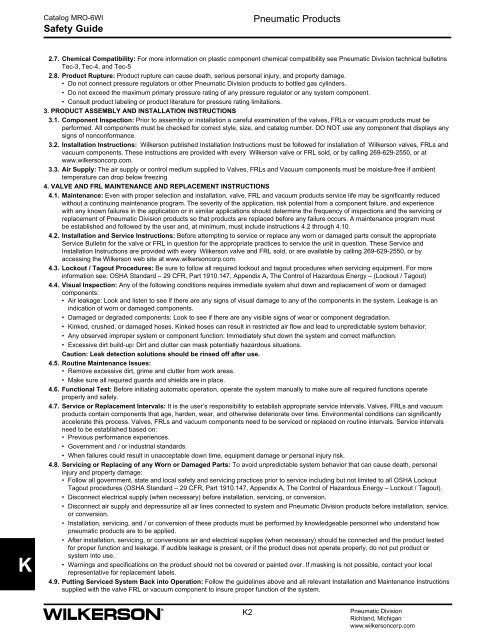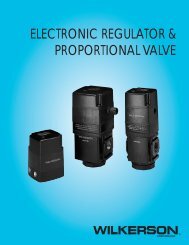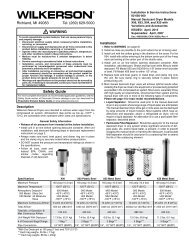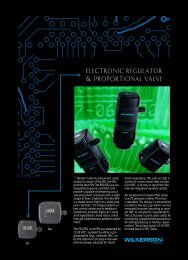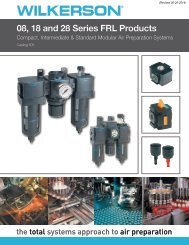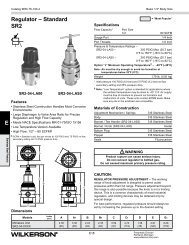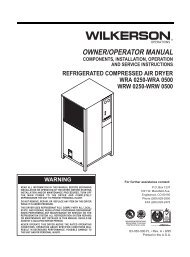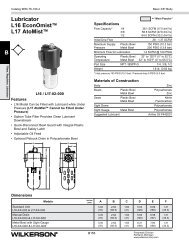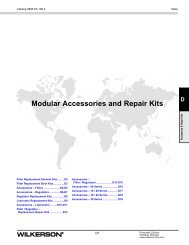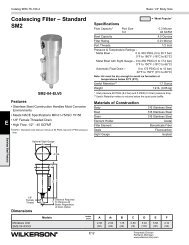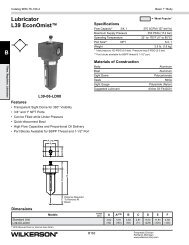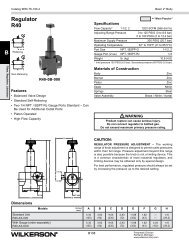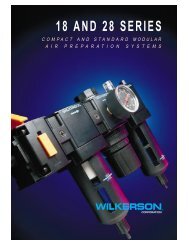Catalog MRO-6WISafety GuidePneumatic ProductsK2.7. Chemical Compatibility: For more information on plastic component chemical compatibility see Pneumatic Division technical bulletinsTec-3, Tec-4, and Tec-52.8. Product Rupture: Product rupture can cause death, serious personal injury, and property damage.• Do not connect pressure regulators or other Pneumatic Division products to bottled gas cylinders.• Do not exceed the maximum primary pressure rating of any pressure regulator or any system component.• Consult product labeling or product literature for pressure rating limitations.3. PRODUCT ASSEMBLY AND INSTALLATION INSTRUCTIONS3.1. Component Inspection: Prior to assembly or installation a careful examination of the valves, FRLs or vacuum products must beperformed. All components must be checked for correct style, size, and catalog number. DO NOT use any component that displays anysigns of nonconformance.3.2. Installation Instructions: Wilkerson published Installation Instructions must be followed for installation of Wilkerson valves, FRLs andvacuum components. These instructions are provided with every Wilkerson valve or FRL sold, or by calling 269-629-2550, or atwww.wilkersoncorp.com.3.3. Air Supply: The air supply or control medium supplied to Valves, FRLs and Vacuum components must be moisture-free if ambienttemperature can drop below freezing4. VALVE AND FRL MAINTENANCE AND REPLACEMENT INSTRUCTIONS4.1. Maintenance: Even with proper selection and installation, valve, FRL and vacuum products service life may be significantly reducedwithout a continuing maintenance program. The severity of the application, risk potential from a component failure, and experiencewith any known failures in the application or in similar applications should determine the frequency of inspections and the servicing orreplacement of Pneumatic Division products so that products are replaced before any failure occurs. A maintenance program mustbe established and followed by the user and, at minimum, must include instructions 4.2 through 4.10.4.2. Installation and Service Instructions: Before attempting to service or replace any worn or damaged parts consult the appropriateService Bulletin for the valve or FRL in question for the appropriate practices to service the unit in question. These Service andInstallation Instructions are provided with every Wilkerson valve and FRL sold, or are available by calling 269-629-2550, or byaccessing the Wilkerson web site at www.wilkersoncorp.com.4.3. Lockout / Tagout Procedures: Be sure to follow all required lockout and tagout procedures when servicing equipment. For moreinformation see: OSHA Standard – 29 CFR, Part 1910.147, Appendix A, The Control of Hazardous Energy – (Lockout / Tagout)4.4. Visual Inspection: Any of the following conditions requires immediate system shut down and replacement of worn or damagedcomponents:• Air leakage: Look and listen to see if there are any signs of visual damage to any of the components in the system. Leakage is anindication of worn or damaged components.• Damaged or degraded components: Look to see if there are any visible signs of wear or component degradation.• Kinked, crushed, or damaged hoses. Kinked hoses can result in restricted air flow and lead to unpredictable system behavior.• Any observed improper system or component function: Immediately shut down the system and correct malfunction.• Excessive dirt build-up: Dirt and clutter can mask potentially hazardous situations.Caution: Leak detection solutions should be rinsed off after use.4.5. Routine Maintenance Issues:• Remove excessive dirt, grime and clutter from work areas.• Make sure all required guards and shields are in place.4.6. Functional Test: Before initiating automatic operation, operate the system manually to make sure all required functions operateproperly and safely.4.7. Service or Replacement Intervals: It is the user’s responsibility to establish appropriate service intervals. Valves, FRLs and vacuumproducts contain components that age, harden, wear, and otherwise deteriorate over time. Environmental conditions can significantlyaccelerate this process. Valves, FRLs and vacuum components need to be serviced or replaced on routine intervals. Service intervalsneed to be established based on:• Previous performance experiences.• Government and / or industrial standards.• When failures could result in unacceptable down time, equipment damage or personal injury risk.4.8. Servicing or Replacing of any Worn or Damaged Parts: To avoid unpredictable system behavior that can cause death, personalinjury and property damage:• Follow all government, state and local safety and servicing practices prior to service including but not limited to all OSHA LockoutTagout procedures (OSHA Standard – 29 CFR, Part 1910.147, Appendix A, The Control of Hazardous Energy – Lockout / Tagout).• Disconnect electrical supply (when necessary) before installation, servicing, or conversion.• Disconnect air supply and depressurize all air lines connected to system and Pneumatic Division products before installation, service,or conversion.• Installation, servicing, and / or conversion of these products must be performed by knowledgeable personnel who understand howpneumatic products are to be applied.• After installation, servicing, or conversions air and electrical supplies (when necessary) should be connected and the product testedfor proper function and leakage. If audible leakage is present, or if the product does not operate properly, do not put product orsystem into use.• Warnings and specifications on the product should not be covered or painted over. If masking is not possible, contact your localrepresentative for replacement labels.4.9. Putting Serviced System Back into Operation: Follow the guidelines above and all relevant Installation and Maintenance Instructionssupplied with the valve FRL or vacuum component to insure proper function of the system.K2Pneumatic DivisionRichland, Michiganwww.wilkersoncorp.com
Catalog MRO-6WIOffer of SalePneumatic ProductsThe items described in this document and other documents or descriptions provided by , its subsidiaries and its authorized distributors,are hereby offered for sale at prices to be established by The Company, its subsidiaries and its authorized distributors. This offer and itsacceptance by any customer (“Buyer”) shall be governed by all of the following Terms and Conditions. Buyer’s order for any such item,when communicated to The Company, its subsidiaries or an authorized distributor (“Seller”) verbally or in writing, shall constitute acceptanceof this offer.1. Terms and Conditions of Sale: All descriptions, quotations, proposals,offers, acknowledgments, acceptances and sales of Seller’s products aresubject to and shall be governed exclusively by the terms and conditionsstated herein. Buyer’s acceptance of any offer to sell is limited to these termsand conditions. Any terms or conditions in addition to, or inconsistent withthose stated herein, proposed by Buyer in any acceptance of an offer bySeller, are hereby objected to. No such additional, different or inconsistentterms and conditions shall become part of the contract between Buyer andSeller unless expressly accepted in writing by Seller. Seller’s acceptanceof any offer to purchase by Buyer is expressly conditional upon Buyer’sassent to all the terms and conditions stated herein, including any terms inaddition to, or inconsistent with those contained in Buyer’s offer. Acceptanceof Seller’s products shall in all events constitute such assent.2. Payment: Payment shall be made by Buyer net 30 days from thedate of delivery of the items purchased hereunder. Amounts not timelypaid shall bear interest at the maximum rate permitted by law for eachmonth or portion thereof that the Buyer is late in making payment. Anyclaims by Buyer for omissions or shortages in a shipment shall be waivedunless Seller receives notice thereof within 30 days after Buyer’s receiptof the shipment.3. Delivery: Unless otherwise provided on the face hereof, delivery shallbe made F.O.B. Seller’s plant. Regardless of the method of delivery,however, risk of loss shall pass to Buyer upon Seller’s delivery to a carrier.Any delivery dates shown are approximate only and Seller shall have noliability for any delays in delivery.4. Warranty: Seller warrants that the items sold hereunder shall be freefrom defects in material or workmanship for a period of 18 months fromdate of shipment from The Company. THIS WARRANTY COMPRISES THESOLE AND ENTIRE WARRANTY PERTAINING TO ITEMS PROVIDEDHEREUNDER. SELLER MAKES NO OTHER WARRANTY, GUARANTEE,OR REPRESENTATION OF ANY KIND WHATSOEVER. ALL OTHERWARRANTIES, INCLUDING BUT NOT LIMITED TO, MERCHANTABILITYAND FITNESS FOR PURPOSE, WHETHER EXPRESS, IMPLIED, ORARISING BY OPERATION OF LAW, TRADE USAGE, OR COURSE OFDEALING ARE HEREBY DISCLAIMED.NOTWITHSTANDING THE FOREGOING, THERE ARE NO WARRANTIESWHATSOEVER ON ITEMS BUILT OR ACQUIRED WHOLLY ORPARTIALLY, TO BUYER’S DESIGN OR SPECIFICATIONS.5. Limitation of Remedy: SELLER’S LIABILITY ARISING FROM OR INANY WAY CONNECTED WITH THE ITEMS SOLD OR THIS CONTRACTSHALL BE LIMITED EXCLUSIVELY TO REPAIR OR REPLACEMENTOF THE ITEMS SOLD OR REFUND OF THE PURCHASE PRICEPAID BY BUYER, AT SELLER’S SOLE OPTION. IN NO EVENT SHALLSELLER BE LIABLE FOR ANY INCIDENTAL, CONSEQUENTIAL ORSPECIAL DAMAGES OF ANY KIND OR NATURE WHATSOEVER,INCLUDING BUT NOT LIMITED TO LOST PROFITS ARISING FROMOR IN ANY WAY CONNECTED WITH THIS AGREEMENT OR ITEMSSOLD HEREUNDER, WHETHER ALLEGED TO ARISE FROM BREACHOF CONTRACT, EXPRESS OR IMPLIED WARRANTY, OR IN TORT,INCLUDING WITHOUT LIMITATION, NEGLIGENCE, FAILURE TO WARNOR STRICT LIABILITY.6. Changes, Reschedules and Cancellations: Buyer may request tomodify the designs or specifications for the items sold hereunder as wellas the quantities and delivery dates thereof, or may request to cancelall or part of this order, however, no such requested modification orcancellation shall become part of the contract between Buyer and Sellerunless accepted by Seller in a written amendment to this Agreement.Acceptance of any such requested modification or cancellation shall beat Seller’s discretion, and shall be upon such terms and conditions asSeller may require.7. Special Tooling: A tooling charge may be imposed for any specialtooling, including without limitations, dies, fixtures, molds and patterns,acquired to manufacture items sold pursuant to this contract. Such specialtooling shall be and remain Seller’s property notwithstanding paymentof any charges by Buyer. In no event will Buyer acquire any interest inapparatus belonging to Seller which is utilized in the manufacture of theitems sold hereunder, even if such apparatus has been specially convertedor adapted for such manufacture and notwithstanding any charges paidby Buyer. Unless otherwise agreed, Seller shall have the right to alter,discard or otherwise dispose of any special tooling or other property inits sole discretion at any time.8. Buyer’s Property: Any designs, tools, patterns, materials, drawings,confidential information or equipment furnished by Buyer, or any otheritems which become Buyer’s property, may be considered obsolete andmay be destroyed by Seller after two (2) consecutive years have elapsedwithout Buyer placing an order for the items which are manufactured usingsuch property. Seller shall not be responsible for any loss or damage tosuch property while it is in Seller’s possession or control.9. Taxes: Unless otherwise indicated on the face hereof, all prices andcharges are exclusive of excise, sales, use, property, occupational or liketaxes which may be imposed by any taxing authority upon the manufacture,sale or delivery of the items sold hereunder. If any such taxes must bepaid by Seller or if Seller is liable for the collection of such tax, the amountthereof shall be in addition to the amounts for the items sold. Buyeragrees to pay all such taxes or to reimburse Seller therefore upon receiptof its invoice. If Buyer claims exemption from any sales, use or other taximposed by any taxing authority, Buyer shall save Seller harmless fromand against any such tax, together with any interest or penalties thereonwhich may be assessed if the items are held to be taxable.10. Indemnity For Infringement of Intellectual Property Rights:Seller shall have no liability for infringement of any patents, trademarks,copyrights, trade dress, trade secrets or similar rights except as providedin this Part 10. Seller will defend and indemnify Buyer against allegationsof infringement of U.S. patents, U.S. trademarks, copyrights, trade dressand trade secrets (hereinafter “Intellectual Property Rights”). Seller willdefend at its expense and will pay the cost of any settlement or damagesawarded in an action brought against Buyer based on an allegation thatan item sold pursuant to this contract infringes the Intellectual PropertyRights of a third party. Seller’s obligation to defend and indemnify Buyeris contingent on Buyer notifying Seller within ten (10) days after Buyerbecomes aware of such allegations of infringement, and Seller havingsole control over the defense of any allegations or actions including allnegotiations for settlement or compromise. If an item sold hereunderis subject to a claim that it infringes the Intellectual Property Rightsof a third party, Seller may, at its sole expense and option, procure forBuyer the right to continue using said item, replace or modify said itemso as to make it noninfringing, or offer to accept return of said item andreturn the purchase price less a reasonable allowance for depreciation.Notwithstanding the foregoing, Seller shall have no liability for claims ofinfringement based on information provided by Buyer, or directed to itemsdelivered hereunder for which the designs are specified in whole or partby Buyer, or infringements resulting from the modification, combinationor use in a system of any item sold hereunder. The foregoing provisionsof this Part 10 shall constitute Seller’s sole and exclusive liability andBuyer’s sole and exclusive remedy for infringement of IntellectualProperty Rights.If a claim is based on information provided by Buyer or if the design for anitem delivered hereunder is specified in whole or in part by Buyer, Buyershall defend and indemnify Seller for all costs, expenses or judgementsresulting from any claim that such item infringes any patent, trademark,copyright, trade dress, trade secret or any similar right.11. Force Majeure: Seller does not assume the risk of and shall not beliable for delay or failure to perform any of Seller’s obligations by reasonof circumstances beyond the reasonable control of Seller (hereinafter“Events of Force Majeure”). Events of Force Majeure shall include withoutlimitation, accidents, acts of God, strikes or labor disputes, acts, laws,rules or regulations of any government or government agency, fires,floods, delays or failures in delivery of carriers or suppliers, shortagesof materials and any other cause beyond Seller’s control.12. Entire Agreement/Governing Law: The terms and conditions setforth herein, together with any amendments, modifications and anydifferent terms or conditions expressly accepted by Seller in writing, shallconstitute the entire Agreement concerning the items sold, and there areno oral or other representations or agreements which pertain thereto.This Agreement shall be governed in all respects by the law of the Stateof Ohio. No actions arising out of sale of the items sold hereunder or thisAgreement may be brought by either party more than two (2) years afterthe cause of action accrues.KK3Pneumatic DivisionRichland, Michiganwww.wilkersoncorp.com


